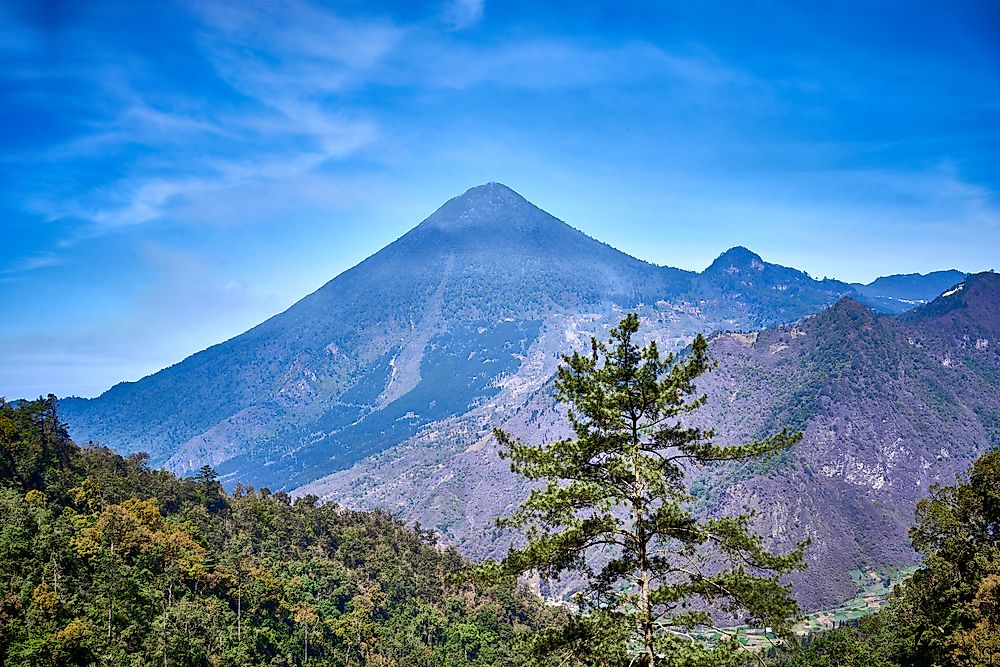What Is The Central America Volcanic Arc?

A volcanic arc is a chain of volcanic features that form an arc shape and normally form above a tectonic plate that has undergone subjugation. During subjugation, one tectonic plate moves under another plate within a subjugation zone. Volcanic arcs are normally curved because they are adjacent to subjugation zones that are curved. Subjugation zones are compression features forming on a convex surface thus taking the Earth’s curved nature. The Central American Volcanic Arc, usually abbreviated as CAVA, is a series of volcanoes that extend from Guatemala to Northern Panama, running parallel to the Pacific coastline. CAVA runs along the western boundary of the Caribbean tectonic plate which is an active subjugation zone.
Location of the CAVA
The CAVA chain runs parallel to the Pacific coastline of the Central American narrow strip of land with water on both side from Guatemala through El Salvador, then Honduras, Nicaragua, Costa Rica, and ends in northern Panama. The whole arc stretches a distance of 930 miles. CAVA lies on a subjugation zone that borders the Caribbean Plate along its western border.
Volcanic Formations Along the CAVA
CAVA has hundreds of volcanic features including lava domes, cinder cones, and stratovolcanoes. A good number of these volcanic features are still active with several recorded explosive explosions. For example, in 1902, the Santa Maria volcano in the western highlands of Guatemala recorded eruptions of Volcanic Explosives Index 6. Other active volcanoes in this region are Costa Rica’s Irazú, Poás Arenal, and Turrialba, Nicaragua’s San Cristóbal, Concepción, and Cerro Negro, Guatemala’s Pacaya, Santiaguito, and Fuego, and El Salvador’s San Miguel, Izalco, and Santa Ana. Guatemala has CAVA’s highest volcanoes like Volcán Tacaná and the Tajumulco, both standing over 4374.45 yards.
Monitoring of Volcanic Activities Within the CAVA
Due to the number of active volcanoes in the CAVA, different government agencies, observatories, and universities constantly monitor volcanism in this region. Most of these observers are members of the World Organization of Volcano Observatories (WOVO).
Mexico
In Mexico, the Observatorio Vulcanologico, Universidad de Colima monitors the Volcan de Colima. Four observers, Centro Nacional de Prevencion de Desastres (CENAPRED), Instituto de Geofisica, Popocatepetl Volcano Observatory (POVO), and Universidad National Autonoma de Mexico (UNAM) jointly monitor the Popocatepetl.
Guatemala
Instituto Simologia, Vulcanologia, Meteorologia y Hydrologia (INSIVUMEH), and Coordinacion Nacional para la Reducción de Desastres (CONRED) jointly monitor the Santiaguito while the latter also monitors volcanic activities of the Fuego and Pacaya.
E Salvador
In El Salvador, four Institutions, Instituto de Ciencias de la Tierra, Universidad De El Salvador (UES), Servicio Nacional de Estudios Territoriales (SNET), and Ministerio De Medio Ambientey Recursos Naturales monitors San Miguel, Izalco, Santa Ana, San Salvador, San Vincente, and Ilopango. UES specializes in Geochemical monitoring.
Nicaragua
Only the Instituto Nicaraguense de Estudios Territoriales (INETER) leads the monitoring of San Cristóbal, Telica, Cerro Negro, Momotombo, Masaya, and Volcán Concepción.
Costa Rica
Finally, in Costa Rica, Observatorio Vulcanológico y Sismológico de Costa Rica (OVSICORI), Instituto Costarricense de Electricidad (ICE), Oficina de Sismología y Vulcanología (OSV), and Observatorio Sismológico y Vulcanológico de Arenal y Miravalles (OSIVAM) monitors Rincon de la Vieja, Arenal, Miravalles, Poás, Irazú and Turrialba.
Satellite Remote Sensing
Satellite technology from different agencies like NASA contributes highly to the monitoring of all CAVA activities. Data collected by the satellites provide details about temperature changes, gas output, and topography. Images from the satellites are usually free apart from few ones sold at a low price.











